Sabine Schut-Kery put her name on the international dressage map when she and Sanceo achieved three personal best scores in Tokyo to help bring home a team silver medal for the USA. While her background in exhibition and stage show riding is a little different to the average dressage rider, this rich tapestry of experience is what led her to that moment in the spotlight.
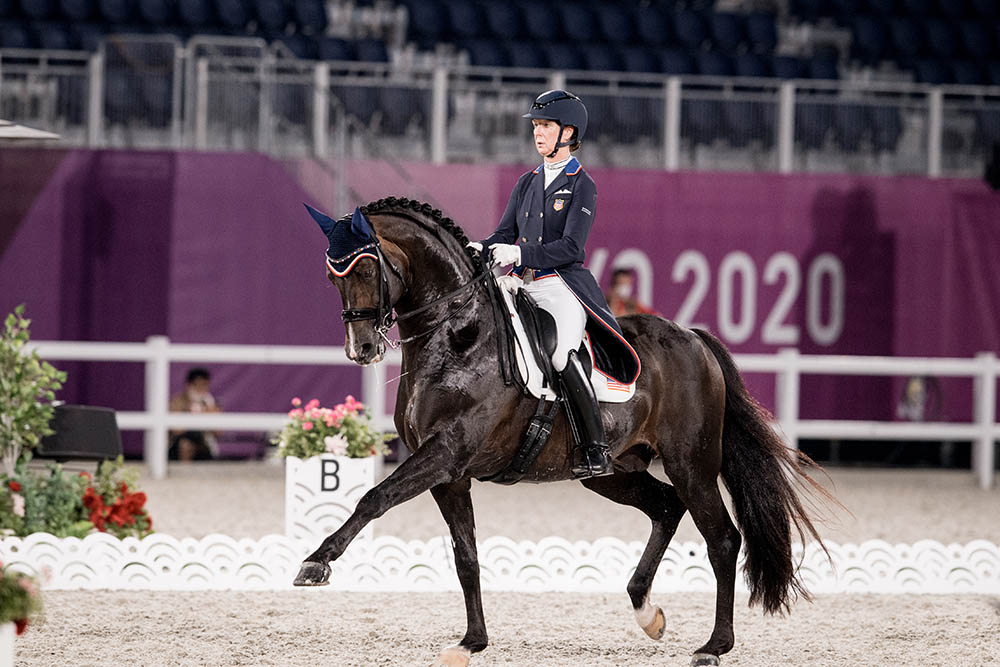
There were many beautiful horse and rider combinations at the Tokyo Olympics, but one that caught the attention of many was the American partnership of Sabine Schut-Kery and the 15-year-old stallion Sanceo.
Unknown to many outside the States, the pair were part of the USA’s silver medal winning team and scored 78.416% in the Grand Prix for seventh place, 81.596% in the Special for third, and 84.3% in the Freestyle for fifth. All three scores topped their previous personal bests of 75.022%, 77.468% and 78.145% across the three respective tests. It’s one thing to achieve personal bests at an Olympics; it’s another to exceed those personal bests by such impressive margins!
“I could definitely say we were on. It was definitely a special show,” says Sabine, reflecting on the achievement. The 53-year-old explains that since stepping up to Big Tour level with Sanceo at the beginning of 2018, it’s been a gradual progression where they’ve built from one show to the next.
“I now know what needs to be done in the ring to pull it all together. Before, I was missing that a little bit… I was always trying to ride mistake-free, but hadn’t figured out how to ask for more. I’m getting to the point now where we’ve had enough mileage in the competition arena and it’s possible to start polishing our performance.”
Speaking specifically about the stallion’s performances in Tokyo, Sabine explains that Sanceo is a very sensitive and soft horse in general, but at the Games he had that extra little spark. “We wanted him to peak there and I think that just worked out so beautifully. What contributed to that, I think, were the two weeks’ quarantine at Aachen and then a week in Tokyo, just having the eyes on the ground from my coach Christine Traurig every single day.
“He felt amazing [during competition]. He felt really zoned in to me; the signals were so subtle, I literally felt like we were speaking the same language. That’s how direct it was. Sometimes these signals can be a little delayed or sometimes you need to say something a little more or repeated, but at Tokyo it was just very direct. I felt like I was speaking horse language.”

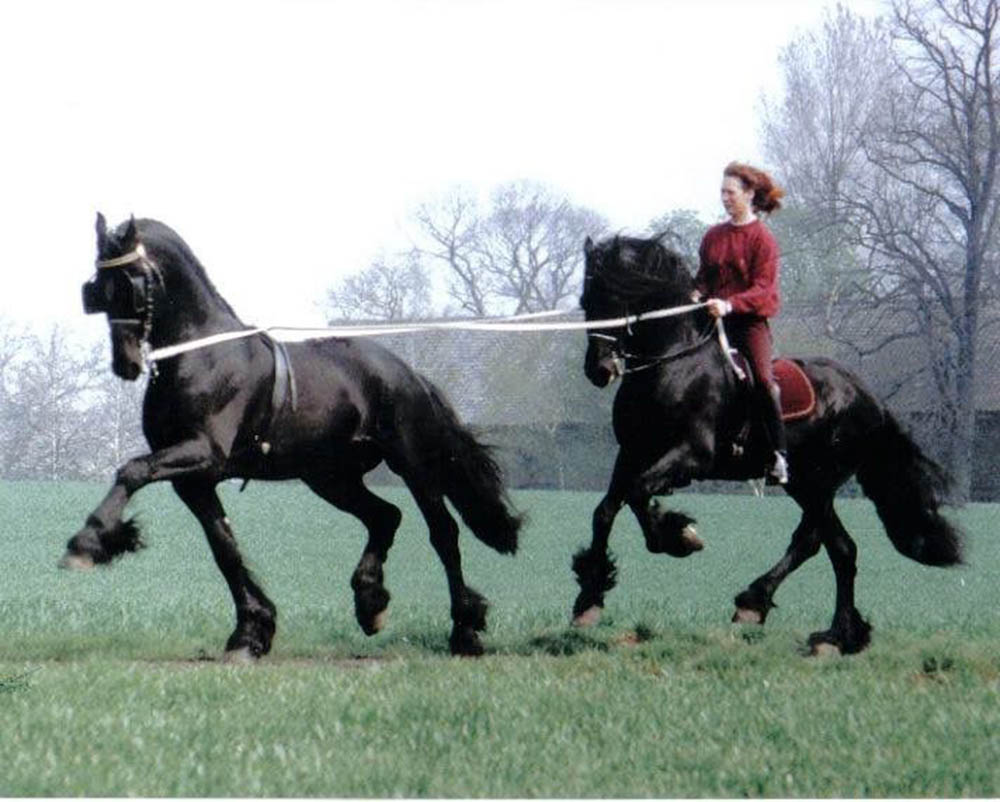
FROM THE BEGINNING
Many who watched Sabine and Sanceo’s breath-taking performances at Tokyo were left wondering who they were and where they had come from. The truth is their success at Tokyo was anything but a fluke. Sabine’s equestrian history is rich and varied; a colourful tapestry of experience that led to the beautiful performances we saw at the Games.
Born and raised in Krefeld, Germany, Sabine explains that horses were an integral part of her childhood. Her parents were not horsey, however, when her older sister took up riding, Sabine tagged along. In the end her sister didn’t stick with it — although she still loves horses — but for Sabine, they have remained a part of her life ever since.
Riding her bike to the local barn, Sabine spent countless hours brushing horses and cleaning stalls. “I literally just went home to sleep and go to school — the rest of my time was spent with the horses,” she recalls, explaining that in Germany, horses are very much a lifestyle and young riders are encouraged to gain a broad range of experience.
Just when Sabine was becoming too tall for the ponies, an opportunity arose at the barn to ride Friesian horses for a gentleman who was the first to import the breed from Holland. “In Germany, nobody knew Friesian horses. The owner wanted to promote the breed as an all-rounder through exhibitions and horse fairs.” Sabine explains the horses were trained in dressage and driving, and to make it entertaining they also taught the horses how to bow, lie down, sit up and rear on command. She worked with the Friesians between the ages of about 14 and 18, travelling for exhibitions and competitions. “I learnt how to ride side-saddle, drive four-in-hand, and also how to ride one horse and drive one in front! It was just a blast!” she recalls.
Always fascinated with learning but without much financial support, Sabine set about figuring out how she could take lessons and progress her skills as a trainer. “I decided to do a three-year government-approved apprenticeship to become a Bereiter (a long-term working student position that allows you to work towards becoming a professional rider).” Sabine completed her Bereiter with renowned German dressage trainer Jean Bemelmans, where she says that although she learnt a lot, she realised that she wasn’t ready to focus solely on the one sport.
Yearning to regain the variety that she had experienced working with the Friesian horses, she returned to her friends who were still performing exhibitions. “We started taking those little exhibitions to bigger places, touring through Europe — and included Lipizzaners from Lipiza, as well as our Friesians.”
While it was great fun, Sabine says they were always very strict that the dressage work was correct. “We didn’t do it for the sake of riding in front of a crowd, there was more of a purpose; we really wanted to do a good job. I think that’s really important when you work a little bit in entertainment, that it doesn’t just become a moment in the spotlight.
“We had horses that performed airs above the ground. We had horses and people that would do trick riding or jousting, chariot driving, and then dressage and side-saddle,” says Sabine, explaining how the exhibition riding evolved to a full-on stage show in its own right that showcased horses and their relationship with humans through the ages. Sabine had various roles in the show, from riding side-saddle as a double for a princess, to performing as part of the dressage quadrille — and many parts in between.
It was during her time working with this show that Sabine met her husband, Kristian Kery. Born in Hungary, he was a horseman from a young age as well and now works in the film industry as a stuntman. Coming from Europe as a child, he was educated in jumping and dressage like Sabine and to this day he still helps her with her horses in training — even riding Sanceo when Sabine is out of town. “It’s good that he loves horses too, otherwise he probably would say I’m spending too much time with them!”

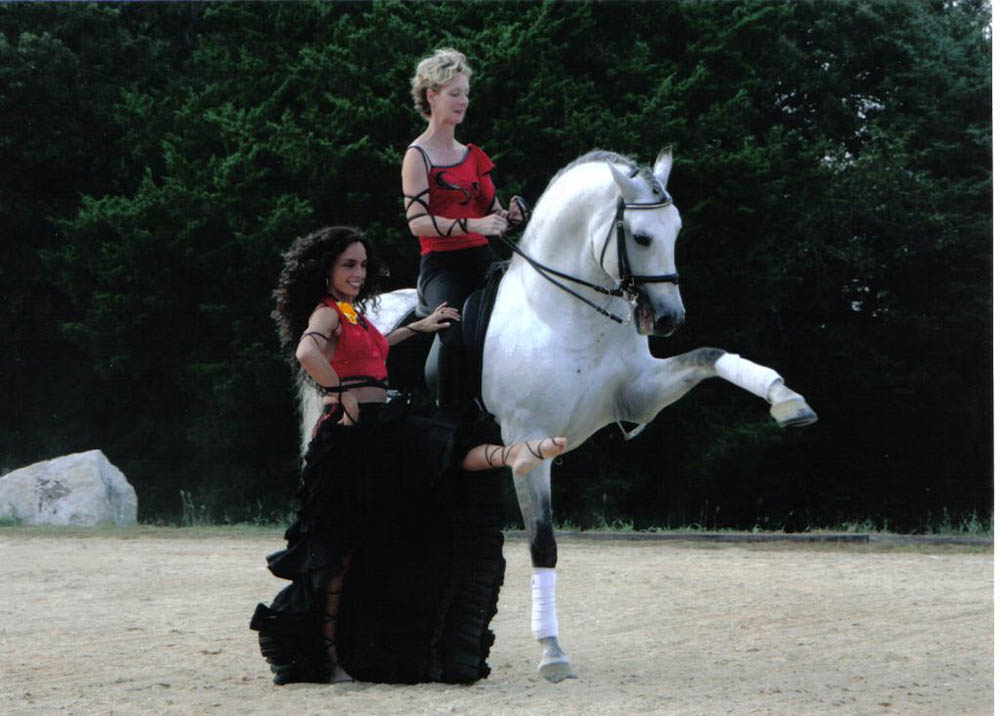
TO THE STATES
Sabine’s move to the United States came about through the sale of the first horse she actually owned — a Friesian that she produced close to Grand Prix level and also trained to perform a variety of tricks. Jim Mosebrook in Texas bought him from a video, and asked Sabine to come over and give him some lessons on how to get the horse to perform.
“I went over and showed him all these tricks, and he was just so blown away and offered me a job on the spot,” says Sabine. And so in 1998, Sabine and Kristian moved to the USA to work at Proud Meadows.
“Jim fell in love with the Friesian breed and wanted to promote them in the United States, and so I almost relived the same role again,” explains Sabine about her first job in the USA. “We went all over the country. My first demonstration was in Madison Square Garden, and I was on the Today Show. It was just an amazing experience.” Sabine explains that her new boss also became fascinated with Andalusians and Lusitanos, and so she worked with those breeds again as well in the States.
During her time in Texas she’d been allowed to fly her trainer, Jan Nivelle, out every year for 10 days so she could continue learning and developing as a dressage rider. Keen to always test her training against the best, Sabine travelled when possible to the equestrian mecca of Wellington, Florida, to compete the Friesians.
In 2005, Sabine “got a little itch again”, explaining that this time her curiosity turned to Warmbloods. “My husband had work in the film industry in Los Angeles, and I visited him and absolutely fell in love with California. And that’s how I started working with my current coach, Christine Traurig.”
And so Sabine moved to California and started working with a new breed; her third Warmblood project was Sanceo.
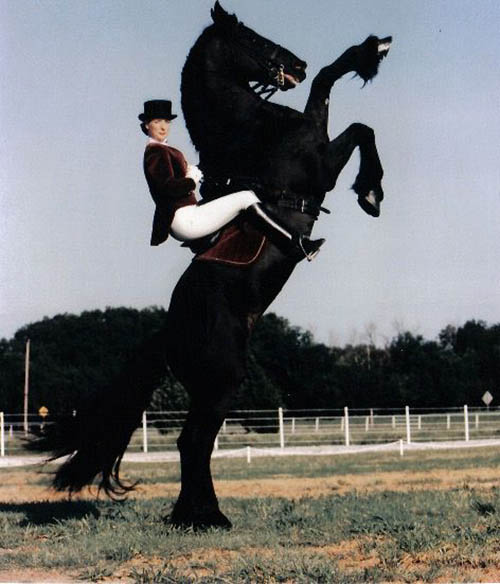
FINDING SANCEO
Alice Womble and Mike Heitman lived in Texas and often came to watch Sabine’s exhibition rides when they were in her home state. “Alice would always come over afterwards to chat, and she’s just this gracious lady who I feel appreciated my riding and always complimented on the softness and the relationship I had with a horse.
“The minute I moved to California and was able to train other people’s horses, she called me and asked me if I would train her stallion. He was a little bit older and a little bit full of himself. He would rear, but not on command. When he reared I was like, ‘Okay, you think you can intimidate me? Just bring it on, because I did this for a living’. But he was so talented… And he started walking on two legs. I opened a can of worms!” laughs Sabine. Despite that little hiccup, Sabine did get Alice’s stallion on side and he was quite successful.
“And then Alice said one day, ‘I want to see what you can do with a horse that you have from the beginning that nobody else has ridden before!’” And so Sabine went to Europe to find a horse, on the proviso that it “must be pretty”.
She went for a week, and hadn’t found anything until she saw the last horse on the trip — a three-year-old by Sam Remo (Sandro Hit x Donnerhall) and with jumping lines on the dam side, being out of a Ramiro’s Son II mare. “I just fell in love with him, not just emotionally, but at just under three he blew my mind at how he could go on a 20 metre circle, on a lunge line, in the same rhythm… he had that push power that he was so committed to without being flighty and running. It was just like an older horse. He had three beautiful gaits, and luckily he was beautiful. So check mark on that!”
Sabine explains the problem was that he was only three times under saddle and she was “too chicken to get on” — but she wanted to see what he felt like to ride before making the call and also knew Alice and Mike would want to see him. Three weeks later, they went back together.
“I rode him and he felt the same as he looked; just this amazing commitment of forwardness with the right balance already at that age. He was forward but not running, just that beautiful, steady rhythm with all this energy coming to the reins in a very balanced way.” Sabine only rode him for five minutes, but she knew he was the one.
And so Sanceo returned with them to the States. “We didn’t know where he would take us. We were hoping, but you just don’t know until they’re a little bit older.”
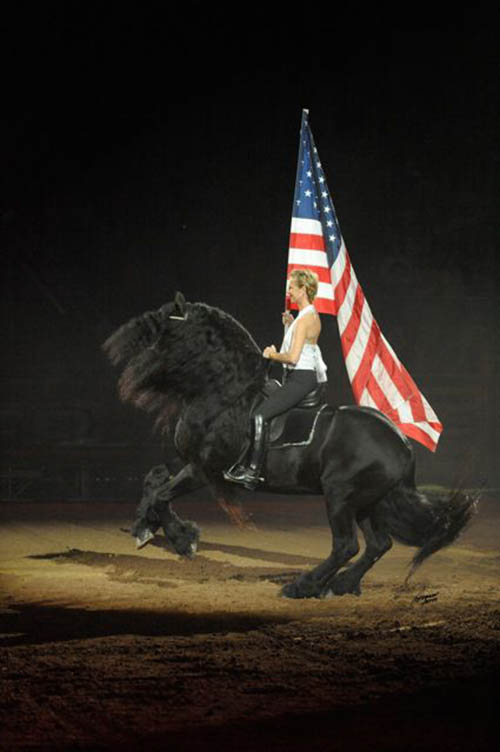
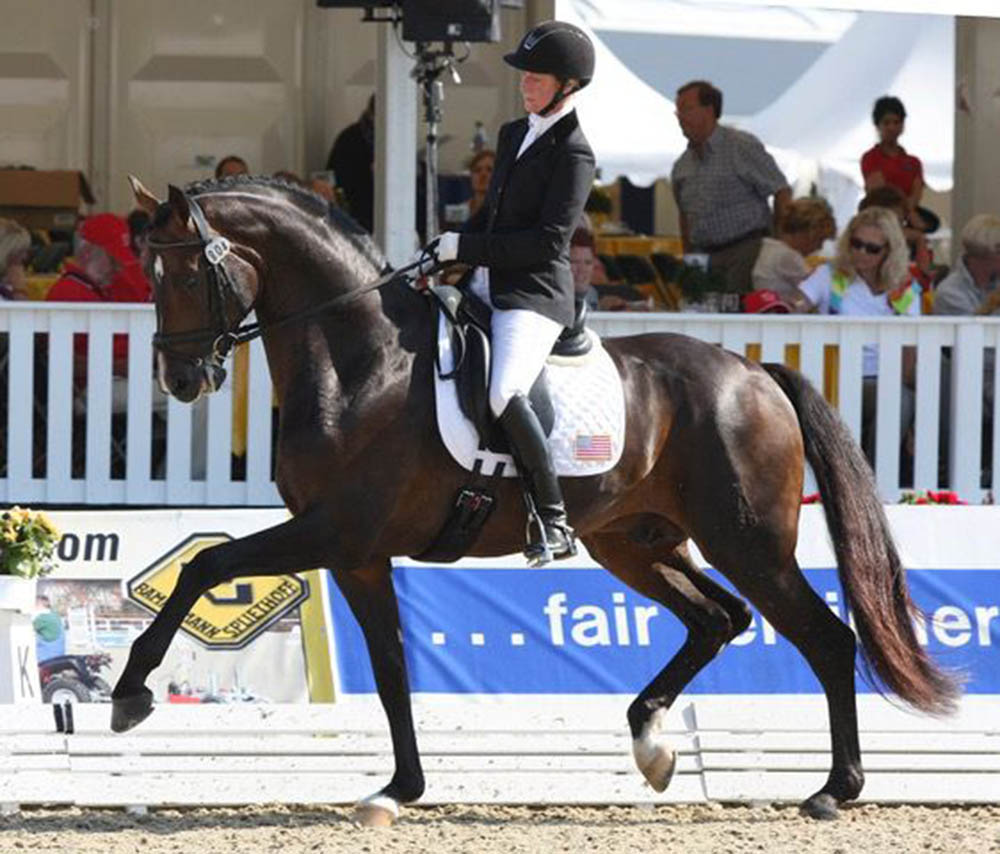
EARLY TALENT
Sabine explains that in the US there is a program designed to take young horses through the grades and eventually on to Grand Prix — and then hopefully representing the USA at major championships. The program provides a tremendous amount of support both financially and also in terms of access to excellent coaching.
“Young horse classes are hard, because you have to be ready at a certain time,” explains Sabine, who had agreed with Sanceo’s owners that they were never going to put the horse on a time schedule. That being said, Sanceo ticked every box with ease as he went, breezing through the US program with flying colours.
“He won the Futurity class in California as a four-year-old, and then as a five and six-year-old he qualified for [the FEI WBFSH Dressage World Breeding Championship for Young Horses in] Verden. Sanceo’s owners and I decided not to take him as a five-year-old because he was a little immature; we instead took him to the national championships where he came fourth. He was quite spooky back then. Then as a six-year-old we took him to Verden; he was not super competitive but we had a couple of good rounds there and it was a good experience.
“They didn’t have seven-year-old classes at the time, so next we did the national championships in the Developing Prix St Georges, which he won with a 78%. From that, we jumped into the CDI Small Tour. On the Florida circuit he won every show we entered that year and had the highest scores. We then went to Europe to compete, and made the US team for the Pan American Games in Toronto, competing Small Tour. So we were on the gold medal winning team there. And then we went on to Grand Prix.”
The pair’s first CDI Grand Prix was at the beginning of 2018, and from there it was about steadily becoming consolidated at the level and gradually improving scores — a trajectory that still seems to be on the rise if their results at Tokyo are anything to go by.
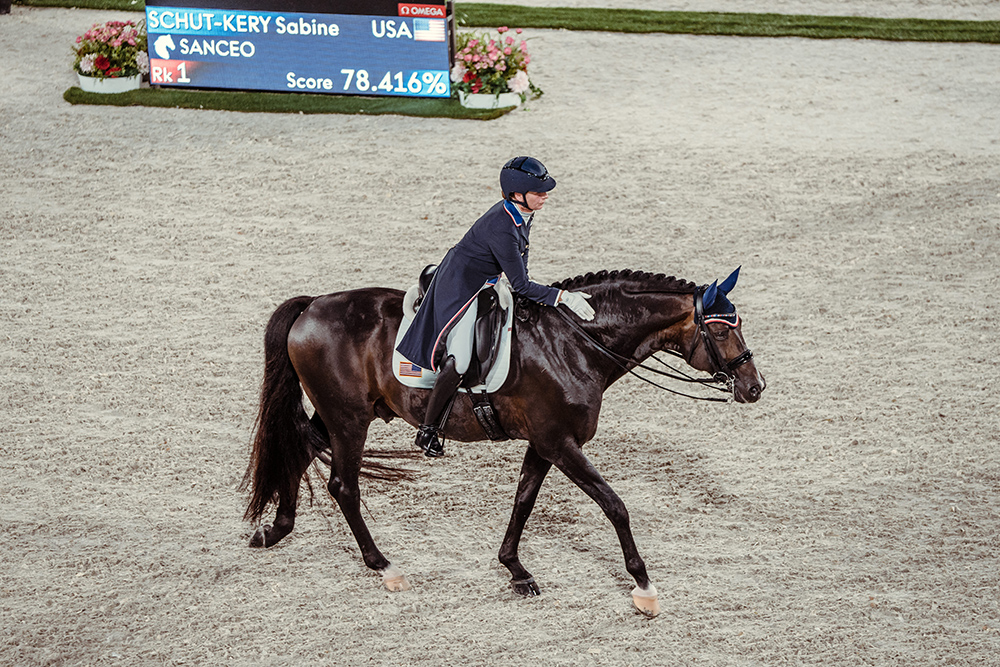
“It’s a tool, to really read and
listen to the minds of horses.”
THE PRESENT
When Sabine first moved to California, she got lucky and found a place at a “very, very beautiful barn” called El Campeon Farms, where she stayed for 12 years. “Last year, I moved up north of San Francisco to Napa, because one of my good clients bought a property and I’m always curious about different parts of the country. It was a nice opportunity… so why not?”
Sabine rides Sanceo three to four times a week, and says there is one part of his training in particular that is non-negotiable. “I can tell you religiously — and people laugh at me because I sometimes put my timer on it — I walk him for 15 to 20 minutes before starting work. This horse has never seen a walking machine; I do the walking. And then my actual workout is never more than 30 minutes. If I don’t get something done, tomorrow’s another day. I rather work a shorter session and a little bit more consecutively, rather than a longer session and then a day off.
“I rarely ride him in a competition frame. I ride him a little rounder, but I have to pay attention because round is not always round; he can look like he’s round, but I have learned from my fantastic coach, Christine, to really pay attention to what round really means. There’s so much more to it than just looking in the mirror… he’s always going to be on the bit, but really truly round, there are a few more ingredients that come with that. In particular with Sanceo, I’m a huge fan of a rounder training frame… but not round on the forehand. Even if he’s in a lower frame, he still has to be in the right balance.”
Sabine believes that variety in training is very important. Sanceo goes on the aqua treadmill at least twice a week, and he does cross training with poles. Trail riding is also part of Sanceo’s schedule, although now in Napa with the current drought, the trails have become very dry — to the point where Sabine explains they can be quite slippery. “What I actually do is hand walk him a lot on the trail, and I also at the same time have a little bit of a workout and then I’m not worried about him slipping with me on his back.”
Following Tokyo, Sanceo is currently having a bit of downtime and also breeding. Up until this point, Alice and Mike have allowed the stallion to be focused on competing rather than stud duties — and so he’s yet to have any progeny on the ground. “He’s having some fun right now, and then from January to March we will go to Florida to compete [for the Global Dressage Festival].”
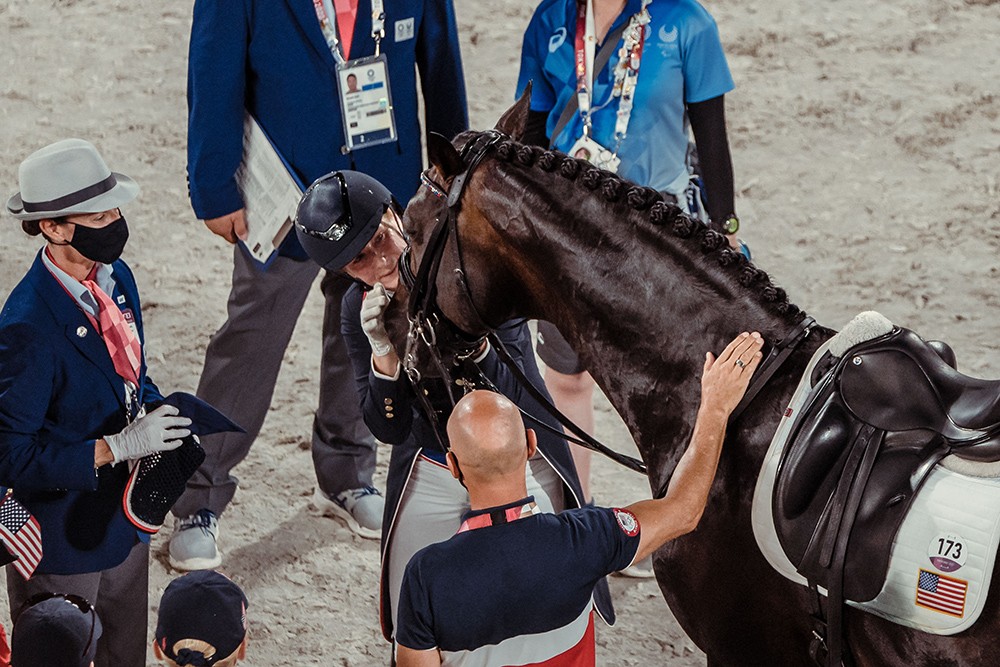
ALWAYS LEARNING
For Sabine, her journey with horses is ongoing. “I just love it; I love learning. And that’s what’s so beautiful with dressage, the learning doesn’t end.”
One might think that at an Olympic Games, an athlete is purely focused on themselves and their own performance — however, Sabine never gives up an opportunity to learn and be inspired by those around her.
“I watched Catherine Dufour’s Grand Prix test and it really inspired me. It made me think to take it slow — and slow doesn’t mean inactive, it’s precision, and each short side is there to prepare for your next diagonal or next centreline. And her ride just put that image in my mind ahead of my test; to take my time, and make it graceful yet powerful. And for the Special, it was Carl Hester’s test [that gave inspiration].
“Another time I watched Charlotte Dujardin warm up. I remember walking away being so inspired and saying to my coach, ‘That girl can ride pirouettes; that’s my vision of pirouettes!’ That’s what my inspiration was from her riding.”
Although well versed in training tricks, driving and riding dressage among other things, Sabine says she never did get to train in the art of liberty work — but it’s something she’s always been interested in. When she was travelling to exhibitions and fairs, she recalls performing at many of the same events as renowned French liberty trainer, Lorenzo. “Oh my God, we had a crush on him!” she laughs.
Learning how to train horses at liberty is something Sabine would love to explore further one day under professional guidance, although for now she’s happy practising a little bit at home: “We have a nice little closed-in arena where I can let Sanceo loose… so I try my own little bit of liberty work!”

FROM EXHIBITIONS TO TOKYO
Following her incredible performances in Tokyo, Sabine says that she’s now starting to realise how her varied background with horses has shaped her to become the horsewoman she is nowadays.
“I think as you get older you realise things that you just naturally do when you’re younger. Whenever I was training horses for exhibitions, I really tried to think about the technical aspects of how to train a horse, individually with their bodies, all the movements — but then a huge part is that you also train the interior, the soul… the temperament and mind. That’s a huge thing for me.
“The exhibitions didn’t require riding from letter to letter. We had a certain choreography, but it’s free spirited. You have to show certain movements, but you can react and make decisions based on what kind of horse you have in the moment. I had, for example, a Friesian that wasn’t the best in the piaffe. I was in the ring with other horses, so when another horse did something and the crowd would clap, it would make this Friesian a little bit excited; that’s when I would do my piaffe. I learnt a lot from riding through feel and reading my horse; reading when he’s ready, or when he feels a certain way.
“It’s a tool, to really read and listen to the minds of horses. If they’re tense, you need to back off in a way that you still stay in the driver’s seat and still have control, but you lighten up a little bit and you’re not adding to the tension. And then vice versa, that you also can push a little bit when you have to, but in an encouraging way and not in a bossing them around way.
“I also love the amount of throughness you have to have when you have to do a piaffe at C like in a dressage test. That also is a huge element of the training, how much your horse is through; that your aids are coming through and being heard in the moment. So it’s the combination [of riding with feel and developing thoroughness] that I really appreciate.”
Sabine has worked with so many different breeds throughout her career, from Friesians and Spanish horses to Warmbloods. “Friesians are known to be the opposite from hot. And then Spanish horses, and now Sanceo, are a little hotter. That is so beautiful for me; I love to read these different types.” Sabine explains that when it comes down to it, dressage is simply training — and so with different breeds, you find different ways to train them and allow them to reach their potential.
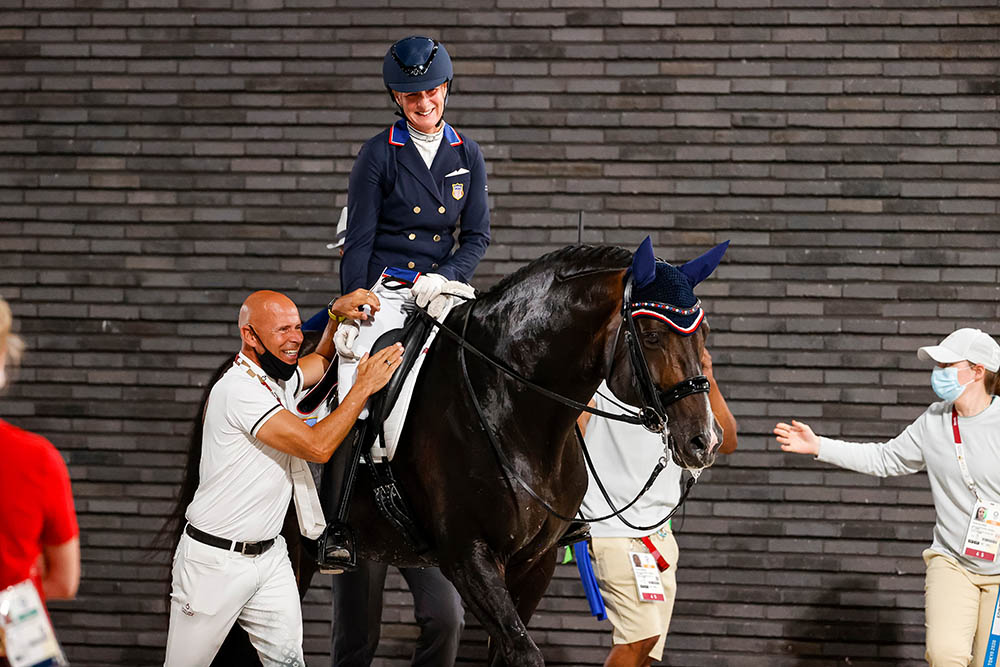
SANCEO’S SOUL
Sabine clearly has a special relationship with the stallion that has taken her to an Olympic silver medal. When talking about what it is that makes Sanceo special, she explains that besides being athletic and physically talented — all horses at the elite level have those attributes — it’s his beautiful soul that sets him apart.
“He is such a good guy. It’s almost like he has antennas; he just always listens, and listens in such a fine way you can have such sophisticated communication with him, which is so interesting and funny.”
Riding at Tokyo, that deep connection was evident where Sabine appeared almost oblivious during her tests to those watching — including the judges — until that final halt where she’d return to reality. “I couldn’t tell you who is around the ring [when competing Sanceo] because it’s so interesting to communicate with that horse. He’s sensitive… even in Tokyo when we came into the ring, he spooked a little bit. But when you start riding him, and you go down the centreline, he just zones in and at that point I feel like it’s just him and I.” EQ
This article was produced from Roger Fitzhardinge’s interview with Sabine Schut-Kery following her success at the Tokyo Olympics. You can watch the interview here.
YOU MIGHT ALSO LIKE TO READ:
Starlite Shines at Brisbane CDN – Equestrian Life, October 2021

